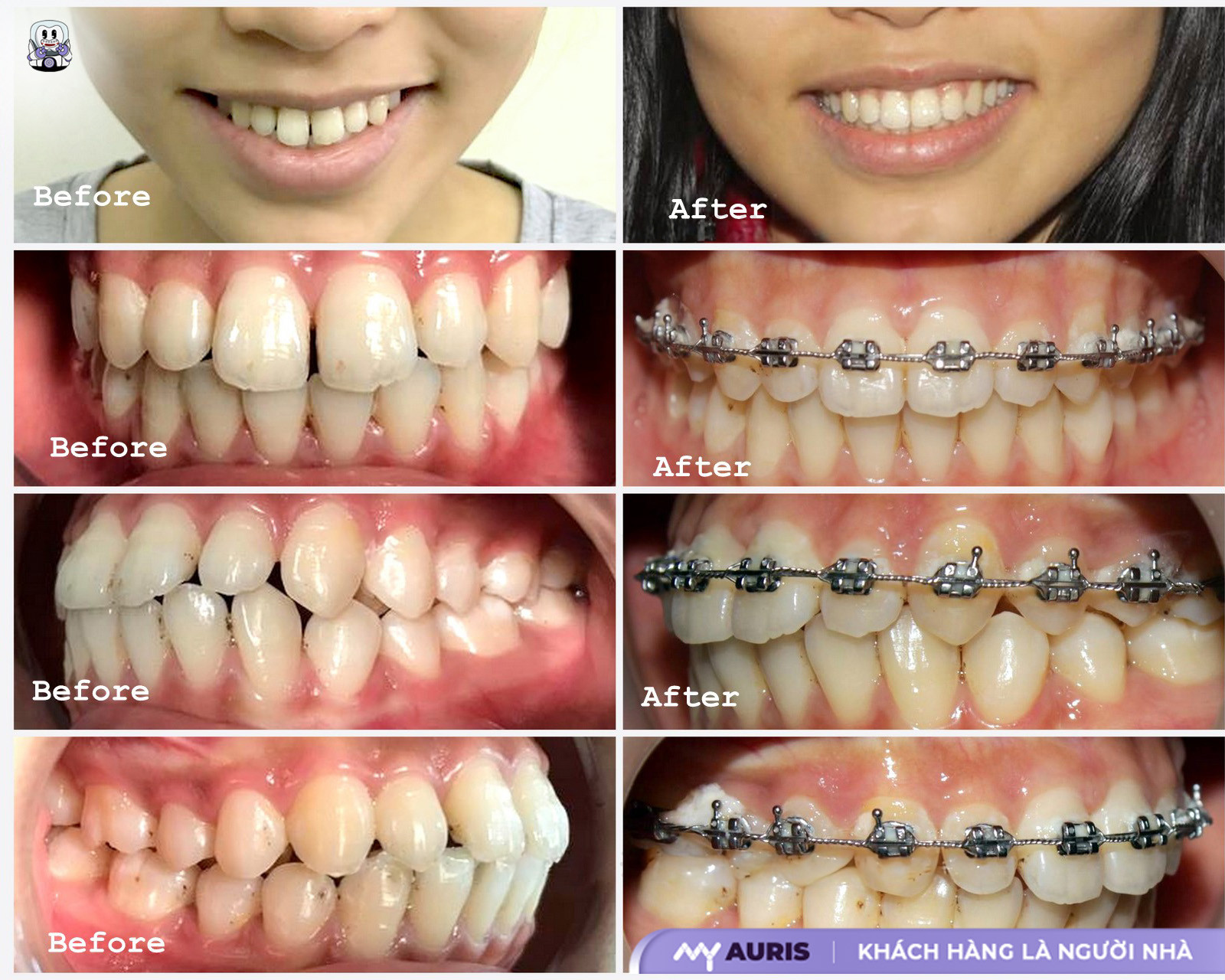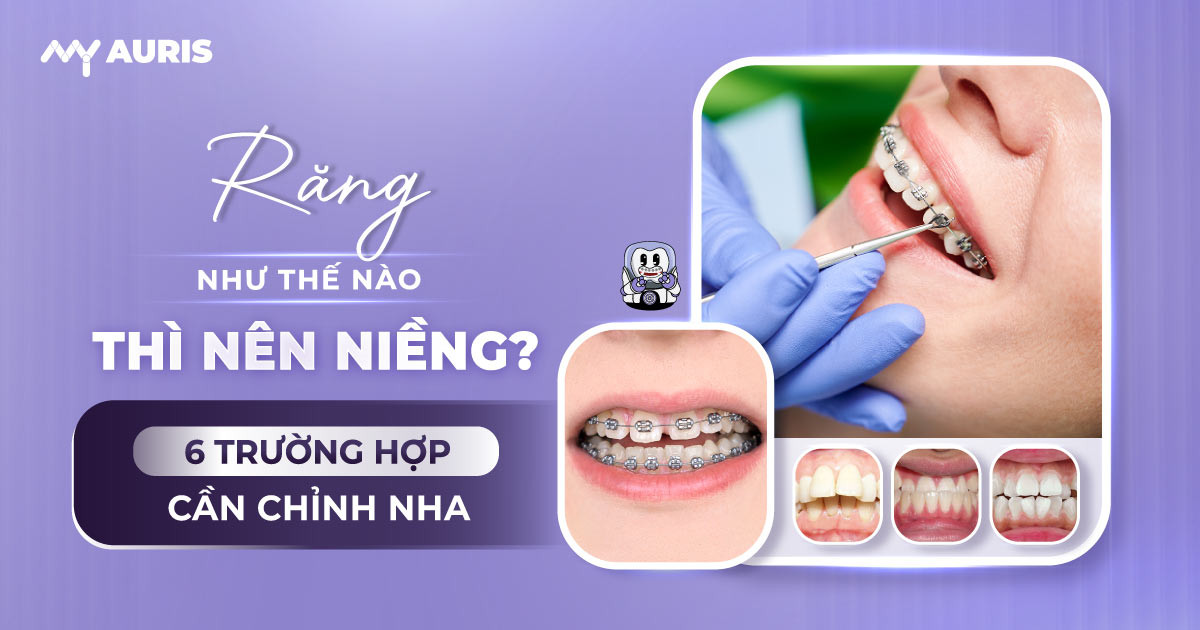Braces are the optimal solution for those who are experiencing dental problems such as buck teeth, underbite teeth, misaligned teeth, gapped teeth, or malocclusion. This orthodontic method not only helps improve smile aesthetics but also brings many benefits to long-term oral health.
What kind of teeth should be braced?
“What kind of teeth should be braced?” This is a common question that Orthodontists frequently receive. Possessing beautiful, straight teeth not only increases aesthetics but also improves chewing function and overall oral health. Below are 4 common cases where you should consider braces to have a more confident and healthy smile.

Protruding teeth
Protruding teeth is a condition in which the front teeth protrude too much compared to the jawbone. and facial structure. This can cause difficulty in closing the lips, causing the lips to protrude forward, and is often accompanied by a gummy smile. Crooked teeth can appear on the upper jaw, lower jaw or both jaws. Braces are an effective solution to overcome this situation, using orthodontic traction to bring teeth into the correct position, improving aesthetics and chewing function.

Undercut teeth
Underbited teeth occur when the lower jaw is too forward compared to the upper jaw, or when the lower teeth cover the upper teeth when biting back. A misaligned chin is also a sign of this condition. In the case of underbite teeth, the choice of treatment method needs to be carefully considered. Braces can help improve mild to moderate underbite. However, in cases of severe underbite due to bone structure, orthognathic surgery may be the optimal solution to achieve the best results.

Teeth Sparse teeth
Split teeth are a condition where gaps appear between teeth, causing an unsightly smile. The cause may be due to missing teeth, congenitally missing teeth, or malformed teeth. If the gaps are scattered across the jaw, braces are an ideal choice to close the gap, helping the teeth fit together Porcelain veneers can be a quick and effective solution.

Misaligned teeth, braces Teeth bring regular, correct bite
Misaligned teeth are a condition in which teeth grow out of alignment in the jaw. This condition not only affects the aesthetics but also reduces chewing function and causes difficulty in oral hygiene, increasing the risk of early loss of baby teeth, imbalance in tooth and jaw size. Overgrown or impacted teeth are common causes of misaligned teeth. Braces are an effective treatment method that helps align teeth, correct bite, improve chewing function and bring a confident smile.

Open bite
Open bite is a common form of malocclusion, in which the two teeth cannot touch each other when closing the mouth. This condition not only affects aesthetics but also causes many functional problems such as difficulty chewing, incorrect pronunciation, and even lisping. If not treated promptly, open bite can lead to serious consequences for oral health and quality of life.
According to dental experts, the main cause of open bite often comes from bad habits such as thumb sucking, tongue thrusting, or breathing through the mouth for a long time. In addition, genetic factors and uneven development of the jaw bone can also contribute to increasing the risk of this condition.

Impacted teeth
Impacted teeth are one of the common dental problems, especially with wisdom teeth. This is a condition in which the teeth do not grow out of the gums but lie completely or partially beneath the soft tissue of the gums. Over time, teeth can separate the gums to grow, but in many cases, it causes serious complications such as gingivitis, jaw pain, or even affecting the tooth pulp.
Braces are an effective solution to treat impacted teeth on a simple level. The dentist will use orthodontic appliances to pull the teeth into the correct position on the jaw. However, if the impacted teeth are too complicated, crooked a lot or cause bite misalignment, braces may not bring the expected results. In this case, tooth extraction surgery is recommended to avoid complications of wisdom teeth and save time and treatment costs.
When should braces be used for adults?
In fact, braces are not only for children or teenagers but are also an effective solution for adults. Currently, about 20% of braces cases are adults, proving that this trend is increasingly popular. However, the time to get braces depends on each person’s age and oral health status. Here are signs that you need to consider braces:
- Crooked or crowded teeth, not aligned properly.
- Difficulty flossing or oral hygiene due to crooked teeth.
- Frequent biting of tongue or inner cheek.
- Teeth do not fit together when the mouth is at rest.
- Having difficulty pronouncing words because the tongue is affected by tooth position.
- Jaw makes noise when chewing or after waking up.
- Feeling tired or tense in the jaw area after eating.
Braces for adults not only bring positive results but also help improve oral health and aesthetics. Many people cannot get braces at a young age due to cost, time constraints or lack of timely diagnosis. However, you are never too old to start treatment. The delayBraces can make the condition of crowded teeth or misaligned bite more serious because the jaw structure changes with age.
Currently, there are many modern braces methods such as fixed orthodontics and removable orthodontics, suitable for each person’s needs and conditions. If you are having problems with crooked teeth or the effects of crooked teeth, contact your dentist immediately for advice and a suitable treatment plan.

Why should you get braces early when your teeth are misaligned?
Early braces are one of the optimal solutions to effectively treat misaligned teeth, especially in children. Orthodontic methods are not only for adults but are also encouraged to be applied early for children to achieve the best results.
According to dental experts, 7-10 years old is the best age to get braces. At this stage, the jawbone develops strongly and is still soft, easily adjusted with orthodontic appliances such as removable braces or jaw expanders. Thanks to that, teeth and jaws will return to the correct position quickly and effectively. Treatment time is also shorter, only about 6-10 months, while minimizing pain during braces.
The older you get, the jawbone will stiffen, making treatment difficult. Braces can last from 1-3 years or longer, depending on each person’s constitution and ability to recover after braces. In addition, wearing braces for a long time can cause discomfort, affect daily activities such as eating and drinking, and even cause damage to the oral mucosa due to friction.
Benefits of braces
Braces are an effective orthodontic solution for cases of buck teeth, underbite teeth, gap teeth or misaligned teeth. Not only does it help improve facial aesthetics, braces also bring many outstanding benefits to oral and overall health.
Improving facial aesthetics
Braces help Adjust the bite to the correct position on the jawbone, bringing balance and harmony to the face. Regular teeth after braces not only create a radiant smile but also help the facial structure become more harmonious. In particular, in the case of protruding teeth, braces can help the nose look higher and cmore comfortable.
Restore chewing function
Protruding teeth, underbite teeth or misaligned teeth not only affect aesthetics but also make it difficult to eat and chew. This condition can lead to damage to the bite joint and jawbone. Braces help adjust tooth position, restore chewing function, support a healthy digestive system and better absorb nutrients.
Prevent oral diseases
Misaligned or spaced teeth make oral hygiene difficult, creating conditions for bacteria to accumulate, leading to diseases such as tooth decay, gingivitis, periodontitis and bad breath. Braces help teeth move to the correct position on the jaw, making it easier to clean teeth, thereby effectively preventing dental problems.
Improves pronunciation
The voice is affected by the coordination between the tongue, lips and teeth. A straight set of teeth will help pronounce more accurately. On the contrary, teeth that are crooked, protruding or underbite can cause slurred speech or unclear pronunciation. Braces help adjust bite and tooth position, thereby improving pronunciation, helping to communicate more confidently and comfortably.
The ideal time to get braces
According to orthodontists, the ideal time to get braces is as early as possible. Early intervention not only shortens treatment time but also helps the tooth movement process go more smoothly and less painfully. Doctors will use orthodontic wires and braces to bring teeth to the standard position on the jaw, ensuring optimal and long-lasting results.
Braces are not only an aesthetic solution but also a comprehensive oral health care method. With outstanding benefits such as improving facial aesthetics, restoring chewing function, preventing dental diseases and improving pronunciation, braces are worthy of being the top choice for those who have problems with buck teeth, underbites or misaligned teeth. Please consult an orthodontist for advice and the most appropriate treatment plan!
______________________
Braces are a dental solution that uses dental appliances such as brackets, wires and trays to create force on the teeth to help bring them to the correct position on the arch. function. function. In addition, this method also overcomes dental problems such as crooked teeth, malocclusion, overbite, underbite, misaligned teeth, etc. So, no matter what kind of teeth you have, you should get braces. The article below will answer all questions about cases where braces should be used.
Should braces be used?
Orthodontic braces are an option.This method has natural intervention and can be influenced by orthodontic appliances. Thanks to that, facial aesthetics are improved, while reducing the risk of some dental diseases.
In cases where customers have some dental problems and need to improve jaw aesthetics, braces will be the optimal choice.

What kind of teeth should be braces?
In addition to determining when you should get braces, as well as finding out the cases that need braces will be important factors that you need to pay attention to. Below are 7 common cases, including:
The case of buck teeth
Hooked teeth are also known as buck teeth. This is a phenomenon caused by the bones, teeth or both protruding forward. This will cause loss of aesthetics and at the same time affect the bite misalignment for those who own it.
Hooked teeth are often divided into 2 levels:
- Slight protruding teeth: In this case, the teeth will move forward and not grow upright, but these conditions are not too serious.
- Severe protruding teeth: This condition can be seen with the naked eye, because the upper teeth protrude quite large compared to the lower teeth.
In case of underbite teeth
Underbited teeth, also known as underbite teeth, is also known as underbite teeth. is an underbite. A normal bite is when the upper jaw covers ⅓ of the lower teeth. When in their natural state, the upper teeth are on the outside of the lower jaw. However, people with underbite teeth will have a plowshare-shaped face and the upper teeth will recede in comparison to the lower teeth.
The case of underbite teeth is divided into 3 levels: underbite due to bone, underbite due to teeth or underbite due to bone and teeth.
Crooked teeth crooked – crowded
Is one of the quite common cases where braces should be performed. Usually, these teeth do not grow in the correct position, protrude outward or recede, causing loss of jaw aesthetics. Furthermore, another cause of crooked teeth is the process of oral care and orthodontic intervention at the wrong time.
Cases of malocclusion
With theCommon malocclusions are butt bite, deep bite, underbite, etc. When you relax your mouth muscles, your jaws will fit together, and you will often even breathe through your mouth instead of your nose. From there, it causes an imbalance between the two jaws and the face.
At the same time, bite misalignment not only causes loss of aesthetics but also directly affects the process of biting and tearing food and pronunciation when communicating. Therefore, many people choose braces to help their bite and jaw become balanced and harmonious.
In case of gapped teeth
Spreaded teeth are a condition in which the teeth grow far apart, especially not close together on the jaw, making you self-conscious when communicating. This is a dental defect that not only affects aesthetics but also affects chewing.
Braces shorten the space of missing teeth
The braces method not only improves the level of jaw misalignment but also helps align teeth for cases where teeth are lost. Furthermore, orthodontics can close tooth loss spaces. To pull teeth to replace lost teeth. Thanks to that, you will not have to get dentures.
Deep bite braces
Deep bite is a condition of malocclusion that causes an imbalance in the upper jaw, causing the lower jaw to recede deeply into the upper jaw. The braces method will help you improve teeth defects, make your face more balanced and youthful.

How does the face change before and after braces?
You will feel it Positive changes in each part of the face, specifically the corner of the nose, chin area and lips. Below are the changes before and after braces in each specific case:
Underbite
- Before braces: The lower jaw will protrude outward and the upper jaw concave. Pronunciation may be slurred.
- After braces: The lower jaw will be pushed back in and the upper jaw pushed out thanks to the traction of the orthodontic appliance. Thanks to that, the two jaws become more harmonious, the nose angle is higher and the lower jaw is slimmer.
Crooked teeth
- Before orthodontics: The upper jaw will protrude forward, making the chin short and making it difficult to close the mouth when relaxing.amm. Moreover, you will feel your cheeks sunken, making your cheekbones high, your face always in a tense and tired state.
- After braces: Teeth will be regular, chin longer, nose angle higher. What’s more, without tension and the lines become more harmonious.
Open bite
- Before braces: when smiling and speaking, misaligned or crooked teeth will make the other person feel like there are too many teeth.
- After braces: The teeth are pulled back to the correct position on the jaw, the angle of the nose and lips become more harmonious.
In short, the most obvious change is when looking at the profile angle before and after orthodontics. When the teeth are no longer protruding or protruding, the nose angle will be higher. From there, your face will change positively, helping you become more confident.

What are the benefits of braces?
You have learned when to get braces and orthodontic cases, the most accurate answer is to get it done as soon as possible. Because orthodontic intervention will shorten the time for braces and simplify the steps affecting the molars. Furthermore, doctors will have enough time to influence tooth movement. From there, bring the teeth to the right position on the jaw without pain, bringing high efficiency.
In addition, when braces are applied early, it will help you have an ideal bite. And limit the risks of dental diseases that affect your health.
Throughout this article, there will be all the useful information and detailed answers about cases of how teeth should be braced. Besides, it helps you have a “steady” mentality before deciding to improve teeth defects with orthodontic braces. If you have questions and need answers about orthodontic methods, please contact us for the most detailed advice!
Kim Dung





